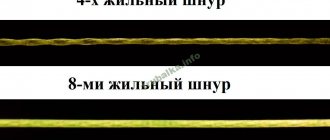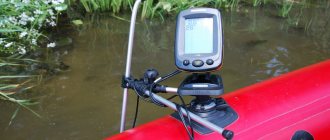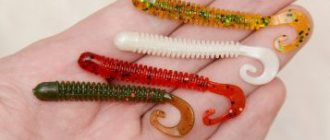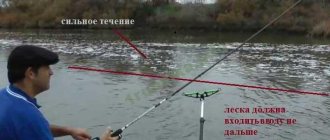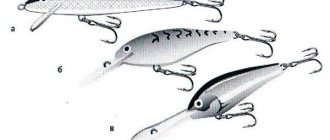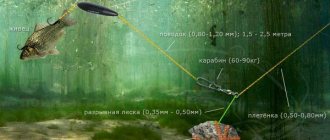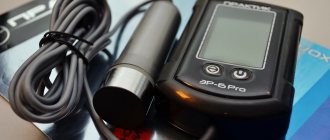What is this device
A downrigger is a design that allows you to fish at a certain depth, holding the bait in the selected horizon for as long as necessary.
This gear is used for fishing from a boat. It makes it possible to conduct wiring at all depths where fish are found.
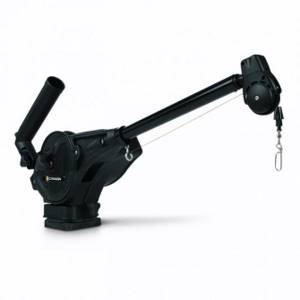
As you can see in the photo of the downrigger, this device is a combination of a special weight in the form of a core with a keel and an angular mount that guides the line.

Fishing with a downrigger is an ideal choice if you are fishing in a large freshwater body or in the sea. Using this device, salmon, trout, catfish, pike perch and other fish are caught.
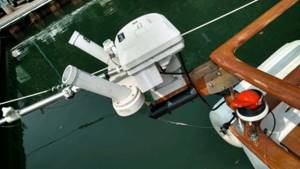
What is Trolling and what are its Advantages?
Trolling is considered one of the most popular and productive methods of fishing in large water areas.
The basic principle of this method is to freely tow the tackle, with the bait attached to it, behind the moving boat. This fishing method can cover a very large part of the reservoir.
In most cases, catching fish at a depth of 6-14 meters requires the use of additional devices to lower the bait to this depth.
The most widely used device among fishermen is a downrigger, invented more than a century ago by Canadian fishermen Scott and White.
3 ways to improve your fish bite!

Over 15 years of active fishing, I have found many ways to improve the bite, and here are the most effective:
1. Bite activator . This pheromone additive attracts fish most strongly in cold and warm water. The Fish Hungry bite activator has proven itself to be excellent - Read more…
2. Tackle with increased sensitivity . You should first familiarize yourself with the features of using a particular type.
3. Pheromone baits . They attract the attention of fish, stimulate hunger and cause a schooling reflex, which allows you to collect a lot of fish in one place.
You can get the rest of the secrets of successful fishing for free by reading my other materials on the site.
3 ways to improve your fish bite!
Over 15 years of active fishing, I have found many ways to improve the bite, and here are the most effective:
1. Bite activator . This pheromone additive attracts fish most strongly in cold and warm water. The Fish Hungry bite activator has proven itself to be excellent - Read more…
2. Tackle with increased sensitivity . You should first familiarize yourself with the features of using a particular type.
3. Pheromone baits . They attract the attention of fish, stimulate hunger and cause a schooling reflex, which allows you to collect a lot of fish in one place.
You can get the rest of the secrets of successful fishing for free by reading my other materials on the site.

Device installation
Wherever you plan to fish - on the sea or in the river - the rules for installing a downrigger will be the same:
- Hang the core load from the side of the craft on a strong winch secured to a rigid bracket.
- At an angle to the load, secure a transition link between the load and the main line - a short leash with a special clip.
- Choose bait based on the fish you want to catch.
- Choose a reliable reel.
- Check the reliability of the bait and clip. The bait should be attached at a short distance from the load.
- Lower the line with the bait to a certain depth and secure with a clip.
- Hold the coil of the device with one hand and release its brake, adjusting it to minimum resistance.
- Wait until the load drops to the desired depth and apply the brakes on both the downrigger reel and the booster reel. Pick up the slack in the fishing line and set the spinning rod to the working position.
Read here Fishing boat - principles of use and secrets of catchability. Essence, effectiveness and features of use (125 photos)

That's all about the downrigger installation system. A bite will lead to the line snapping out of the clip and the rod straightening sharply.

At this moment, the main thing is to take the rod in your hands in a timely manner and pull the prey out of the water. Next, you should lift the load again and reload the line. The device is ready for reuse.

When installing the tackle, it is important to remember that the attachment of the downrigger to the side of the boat must be rigid. This will allow you to use it as efficiently as possible.

Trolling with a downrigger: not so simple
Among the great variety of types and methods of fishing, trolling stands apart. This is largely due to the ambiguous status of this type of fishing. After all, until recently it was banned in Russia. These days, the bans have been partially lifted, but in some regions restrictions continue to apply.
It is worth noting that this method is quite expensive. To satisfy your own ambitions, you will need to acquire a swimming device and equip it with a motor. Add to this a high-quality echo sounder, fairly powerful equipment and expensive baits. Some representatives of this “class” do not limit themselves to this, adding special devices to their arsenal that allow them to reach a higher level of fishing skill. Downrigger is one of them.
It is known that some species of fish (especially their largest representatives) live most of the time at decent depths. And getting to them, using all the variety of modern baits, can be quite difficult for fishermen, and often simply impossible.
Using a downrigger allows you to solve such problems by delivering the bait to the desired layer of water. The necessary information, both on detecting the fish itself and the depth of its habitat, will be provided by an indispensable assistant in this matter - a multifunctional echo sounder. The most popular depth range for downrigger fishing is 10 to 30 meters. If desired, a depth of 100 meters can be achieved. To do this, it is enough just to increase the weight of the load.
A device that is essentially reminiscent of a simple winch with a small reach and a pulley at the end. The downrigger is rigidly attached to the transom or side of the boat. Consists of the following main elements:
- Volumetric drum with a handle for winding the cable and a stopper function. On more advanced models there is a depth indicator in meters.
- The thickness of the downrigger cable depends on the degree of its load and the intensity of the current. For convenience, marks can be placed on the cable indicating the amount of immersion.
- A load, usually drop-shaped, is suspended at the working end of the cable. Its weight is directly dependent on the fishing depth. Approximately, for every 10 m of dive, the weight of the downrigger load is increased by 1 kg.
- At 35 - 45 cm from the load, a very important piece of equipment is attached to the cable - a clip (clothespin) into which the fishing line is tucked.
- The rod itself (usually a powerful spinning rod) is inserted with the butt into the holder, next to the downrigger.
Photo 1. Downrigger kit.
Thanks to the many models on the market, every angler can choose the most suitable downrigger for himself. The only differences are in their sizes and materials. The most expensive models are equipped with an electric drive and a gear depth counter. Canadian manufacturers are rightfully considered the leaders in this industry.
Despite some design differences and additional options, the operating principle of the entire family of downriggers is the same.
- The cable from the drum is pulled along the boom and hung above the water through a pulley. In this case, the boat moves at low speed.
- A load of the required weight is attached to the cable and a clip is attached.
- The spinning line with bait is lowered into the water several meters (depending on fishing conditions).
- Next, the fishing line is fixed with a clip. The degree of fixation should not be excessive, otherwise the bite may simply not be noticed. The fish must use its own power to release the line from the clip.
- Hold the drum with your hand and release its brake. It is important to adjust the multiplier brake of the fishing rod to the minimum resistance.
- Once the specified depth is reached, tighten the brakes on both the reel and the bait reel. Take out the slack in the fishing line and set the spinning rod in the working position so that its tip is bent into a small arc.
- At the moment of a bite, the fishing line snaps out of the clip, the rod straightens sharply and automatic hooking occurs. It is important for the fisherman not to miss this event and, taking the spinning rod in his hands, carefully bring the fish to the surface and catch it with a landing net.
- Then you need to lift the weight and load the line into the clip again. The tackle is ready for use again. Of course, having the electric drive option available, the process of controlling the gear is much more comfortable and efficient.
Advantages of using a downrigger:
- The main advantage of the device is that the bait is placed in a given horizon.
- Ability to work with absolutely any bait.
- Contact with biting fish is not limited in any way. The process of fishing it is a matter of technique for the fisherman himself.
- The ability to choose when purchasing the most suitable model option for a specific watercraft, purpose and wallet.
- The probability of catching rare species of deep-sea fish (trout, trout), as well as trophy pike, catfish, and pike perch, increases.
Photo 2. Upper part of the device.
Among the disadvantages mentioned by fishermen are:
- Relative bulkiness of powerful versions of the device.
- Decent price.
- The need to make your own weights.
In the summer months, the surface layers of water warm up significantly. This forces predatory fish to descend into cooler bottom layers, where ordinary fishermen cannot reach them. In this situation, only trolling with a downrigger allows you to successfully catch a predator.
Modern echo sounders help detect this conventional boundary between warm and cold waters, called the thermocline. Its thickness rarely exceeds 1 m. For peaceful fish, this watershed is very important. Large reserves of nutrients and undissolved oxygen are concentrated here. She prefers to feed on its upper or lower borders. Consequently, this zone with all its contents also attracts predators. Therefore, it is imperative to catch it.
You can use two spinning rods on one downrigger at once. To do this, just add a second clip-clamp to the cable. The distance between the clips should be approximately equal to the thickness of the thermocline. This technique will increase fishing productivity.
Photo3. Downrigger weight.
The speed of the vessel when trolling is also important. Experienced fishermen lower various baits into the surface layer of water and, by changing the speed of the boat, reveal the mode of their most vivid game. Then, already in “combat conditions”, observing this speed limit, you are guaranteed to get the best behavior of the bait at depth.
Beginner fishermen often find it difficult to choose the distance from the clip to the bait. Here you need to adhere to the following theory: the shallower the depth, the longer the leash. A boat passing right over the head of a predator will certainly force it to retreat. But when he, seeing that the danger has passed, decides to return to position, a calmly floating wobbler can provoke him to attack.
You can’t ignore such an unpleasant topic as hooks. It is also difficult to part with hooked baits, but the presence of special release devices, as well as replacing the winding rings of wobblers with braided ties, help to get out of an awkward situation with honor. It's another matter to hook the downrigger weight while moving. If a lost wobbler can be replaced with another bait, then carrying a supply of multi-kilogram weights with you is quite difficult. The result is a spoiled mood, loss of cargo with a considerable part of the cable, which will have to be cut off with your own hands.
You need to be very careful in bodies of water with large differences in depth. It is better to study all its features in advance. And the best solution would be to have an experienced mentor nearby.
Advantages of the method
A downrigger has a number of advantages. It allows you to:
- conduct wiring in the selected horizon;
- choose any bait;
- test your fishing skills;
- catch a rare trophy.
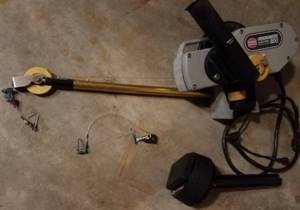
Minuses:
- large sizes of some modifications;
- high price;
- you need to make the weight yourself.
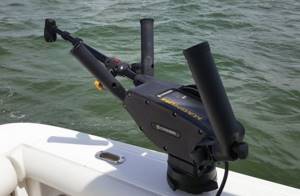
Advantages of a downrigger winch
To wire the bait, it is enough to set the required horizon. You can also use absolutely any size bait. There are no restrictions on contact. The process of catching fish is determined by the fisherman himself. The choice of purchasing the most suitable downrigger option is not limited by the type of watercraft, purpose and wallet. At the same time, the probability of catching a rare deep-sea species increases: trophy pike, catfish or pike perch.
Features of self-made downrigger
Making a downrigger with your own hands is not an easy task, but it is doable. On the Internet you need to find the necessary drawings of each part of the device and make them as carefully as possible.
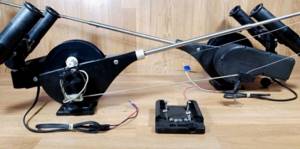
The entire structure must be assembled sequentially, without haste. It is definitely worth checking the reliability of its attachment to the watercraft.
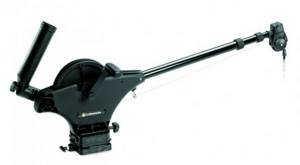
There is nothing difficult about fishing with a downrigger. It is enough to carry out a few practical lessons with an experienced fisherman, and you yourself can easily use this device.

Another advantage of downrigging is that it allows you to attach more than one fishing line with bait to one load and easily control the fishing horizon.

Just familiarize yourself with a number of simple recommendations and the productivity of your trolling will increase significantly.
Note!
- A nod for do-it-yourself winter fishing - how and what to make good gear from. 115 photos and video tips from the pros!
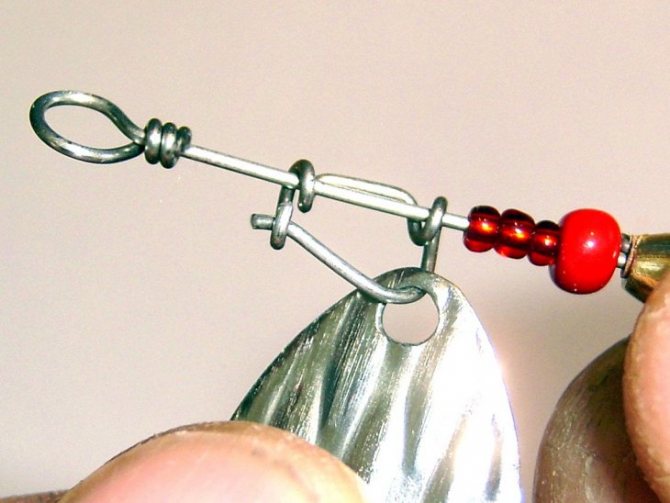
Do-it-yourself spinners - types, features of homemade spinners and their assembly (100 photos and videos)

How to minimize fishing costs? Useful tips from experienced fishermen and an overview of current solutions (65 photos)
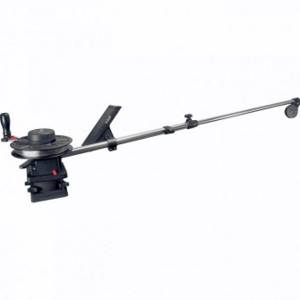
Principles of gear placement
Previously I talked about different gear layouts when using a glider system. In fact, in most cases, gliders and downriggers work simultaneously and complement each other in search of working depth. One of the glider placement schemes was designated by the Latin letter W. Downriggers fit perfectly into this scheme, and in this case the use of surface baits running in the wake of the boat is provided.
If we consider a specific arrangement on one cable, then the lower clip is most often placed in close proximity to the weight, the upper one – at a distance of at least 2 m higher along the cable. When great depths are fished and it is possible to place a sufficient number of spinning rods at the stern of the boat, the number of clips can be increased. But it should be remembered that if a fish bites on the lower tackle, the rest of the tackle may become tangled. Therefore, many experienced fishermen recommend immediately removing all other gear involved.
Read: Trolling Reels
Experienced anglers never treat one downrigger as a separate entity. In other words, if a boat has two or more downriggers, each of them will cover a different range. The starting points can be the bottom or thermocline, the boundary of suspended matter and clear water. The vertical can sometimes be quite extended; in practice, we only guess in which conventional sector the fish is located, and therefore the greatest coverage allows us to quickly check our guesses.
The use of “mobile” depth baits in such schemes is also appropriate, but only in combination with gliders or baits walking in the wake. Additional deepeners, which we call mobile, are never used in tandem with a downrigger. Firstly, because it is not necessary. The downrigger allows you to reach almost any depth. And secondly, we only approximately understand the working depth of the bait charged with a mobile deepener.
When arranging gear, you should thoroughly study the bottom topography and changes in depths. The statement “fish swim along the bottom” is undoubtedly based, but in trolling it is extremely rare to fish bottom areas. Using a downrigger on uneven bottoms can result in serious snagging and loss of weight, time, nerves and often a significant portion of the line. To avoid such problems, it is necessary to study the water area in advance, especially since modern electronic charts allow this. Underwater currents, changes in water density, and boat speed often change the depth at which the weights are immersed. How much the depth of its actual position corresponds to the meter readings can be understood by the angle at which the cable goes into the water relative to the boat.
Gear located closer to the side of the boat, but installed on gliders, is very often equipped with various modifications of mobile deepeners. I most often use cargo deepeners by installing them on both sides of the two closest rigs. For example, if we take as a basis the actual depth of 50 m and the classic arrangement of gear, the diagram will look like this (view from the stern from left to right): 0.5-1.5-7-12-25-35-1-2, 5-30-40-10-8-1.5-0.5. This digital code contains simple information indicating the depth of the bait. So the numbers 0.5, following in this order, the first four positions on the left and the last four positions on the right (0.5-12 and 10-0.5) correspond to gear working on gliders. In this case, the baits closest to the side of the boat, going at depths of 7; 12; 10 and 8 are equipped with additional mobile deepeners. Lures operating at depths of 1 liter 2.5 m, occupying the middle of the “arrangement”, are located in the wake of the boat. Lures corresponding to depths of 25 and 35 m work in tandem with the left downrigger, and fishing depths of 30 and 40 m, respectively, with the right one. Thus, it is clearly visible how wide the opportunities are open to the fisherman. The depths indicated are approximate and should not be taken into account in practice. In fact, the depth range depends on many factors. If the angler is sure that the fish is in the lower layers of the water, for example below the thermocline, located at a depth of 18 m, then absolutely all baits can be lowered to the working range. Conversely, when fish are hunting near the surface of the water, there is no need to significantly deepen the bait. The indicated scheme can be considered “classical” and corresponds to the Latin letter W.
Photos of downriggers
Note!

Do-it-yourself boat motor - tips for beginners, projects, drawings and step-by-step description of the construction of the main components and elements (video + 120 photos)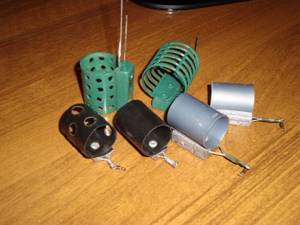
Feeder for winter fishing - secrets of use and techniques for feeding fish in winter (115 photos)

Bottom gear - the most effective types of equipment and features of casting techniques (95 photos and videos)
Help the project, share on social networks 

1+
What is a downrigger
I think many people are interested in this question. I was personally interested, which is why I decided to write a whole article about its manufacture and operating principle. I decided to leave my contribution to fishing culture, so to speak.
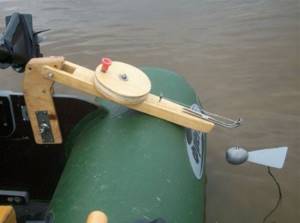
Let's look at what classic tackle consists of. It includes a number of nodes connected in a certain way. This:
- Cord or cable ( better cable is more reliable
); - Coil;
- Arrow with mount for spinning rod;
- Sinker;
- Clip with snap for fishing line;
- Mechanism for attaching to a boat.
The detailed operating principle and design of the downrigger is described in the video below. It also provides certain points and small tricks for fishing on the track using it. I invite everyone to watch.
Installation Instructions
Page 8
- Image
- Text
8
All Scotty powered downriggers are mounted on a Scotty model turntable «1023»
supplied in the kit. This platform can be bolted directly to the gunwale of the boat or on top of any other load-bearing structural element (options on page 14). The downrigger can be mounted at the bow or stern of the boat, on board or on an outrigger console, but it is best to mount it at the stern of the boat. The performance of the downrigger does not depend on the installation location, but the danger of the gear getting wrapped around the propeller is the least when the downrigger is located in the stern of the boat.
When working with a downrigger, you will need to lift and lower weights, assemble and disassemble gear, so you should provide a comfortable and safe place for work where nothing will hinder your movements.
Connecting the System
cable hold ( No.3025
)
will greatly facilitate the process of working with the device. Since the gunwale of the boat at the location where the downrigger is installed will experience heavy loads when the downrigger boom is operating, it is recommended to reinforce it in this place with a metal or wooden plate in advance. This will reduce the risk of damage to the boat if the sinker gets caught on the bottom.
When choosing a location for installing a downrigger, you should consider the installation location and the stroke of the rod holder. Downriggers "Scotty" with an electric drive of the "HP" type are equipped with two types of rod holders - cantilever and two-support. In fact, you can use either the complete rod holder or install another holder. The rod holder works equally well whether it is installed before or after the downrigger.
Installation Instructions

